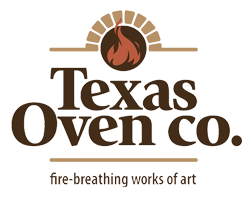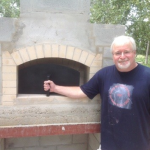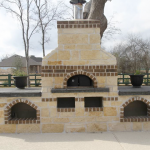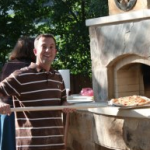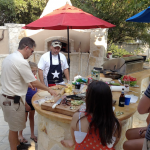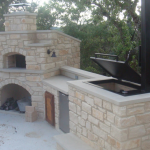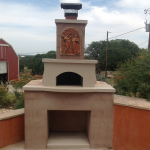Seasoned Wood Key to Efficient Fire
Burning properly seasoned wood in your oven has several benefits. When you read on-line comments and advice about seasoned wood, everyone agrees that it lights fast and burns hot and clear. Clear, meaning with a minimum of smoke. (See our blog about how to build a low-smoke fire.) A smoky fire pollutes the air and can build up as creosote in the chimney.
One of the best things you can do for your oven is to burn seasoned hardwood that has been cut to the right length, and double split. How do you know if the wood you’ve cut yourself, the wood you’ve gotten from a friend, or the wood you buy from a seller is properly seasoned hardwood?
If you cut your own hickory, pecan, oak, cherry, mesquite or other hardwood, stack it outdoors and let it dry at least a year. Some folks cut their wood and stack it in early spring to take advantage of drying summer heat. The key is to know your wood. Is it sufficiently seasoned in one year or two? Are the ends of the logs grayish? Do they show cracks and/or radial splits? If you whack two pieces together, do they make a ringing, sharp sound? Do the pieces feel light for their size?
Donated wood without a history? Check its appearance for color and drying cracks. Give it a whack test for sound. Set it aside for six to 12 months, or check it with a moisture meter. You can purchase an inexpensive moisture meter online or at your local home improvement store. Until you are comfortable judging moisture by feel and appearance, a moisture meter will measure the wetness of a split log.
The best seasoned hardwood has a moisture content of 20% or less. Green (meaning unseasoned) wood may have a moisture content above 50%. It’s slow to start, making it difficult to get a fire going. If you build a top-down fire and still struggle to get a smoke-free fire burning quickly, unseasoned wood is the likely culprit. It may hiss or sizzle as the heat evaporates the moisture in the wood.
Green wood tends to smoke and it deposits acidic water in the form or creosote in the chimney. A good percentage of the energy generated from burning wet wood goes into drying out the water remaining in the wood instead of generating heat. You will end up using more wood to heat your oven.
In other words, save time, frustration and money while you help the environment. Learn to recognize properly seasoned wood and fire your oven efficiently with well-cured hardwood.
How to Recognize Seasoned Wood
Find a reputable seller. I don’t have wood to cut on our property but order from Butler Wood. They deliver wood to our outdoor rack on a regular schedule. Butler Wood has many commercial customers and has built a good reputation for delivering fireplace and cook wood at a fair price. Not all wood sellers are equal, however, so ask about the wood, have a piece split, check its general feel and appearance.
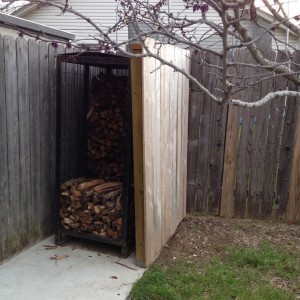
This wood rack from Butler Wood holds about 35 cubic feet of double-split wood when full.
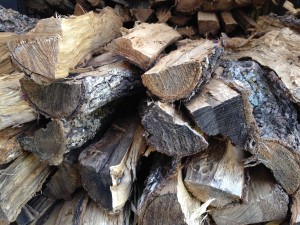
Double-split oak with a moisture content below 10% burns efficiently. Using seasoned wood means energy goes to generating heat rather than burning off moisture.
Look at the ends of the logs. They should have a grayish color. Well seasoned wood will show cracks and/or radial splits.
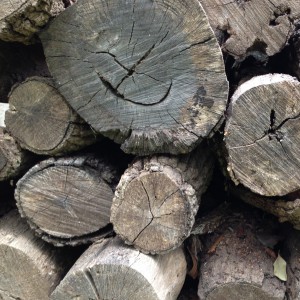
Seasoned hardwood will feel light and make a ringing sound when you whack two pieces together. Look for grayish color at the ends of the logs. Well cured wood will show cracks and/or radial splits.
When in doubt use a moisture meter. If your fire is smoky or sluggish double check the moisture content in your wood.
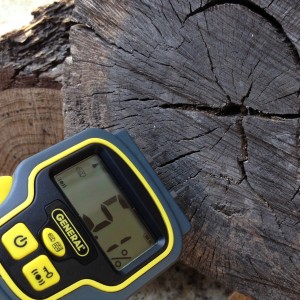
Visual clues like the color and splitting are confirmed by the moisture meter. This wood contains little moisture.
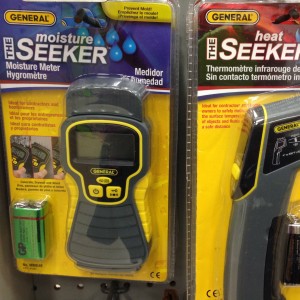
Moisture meters are available at different price points online and at most home improvement stores. This inexpensive model costs about $25.
